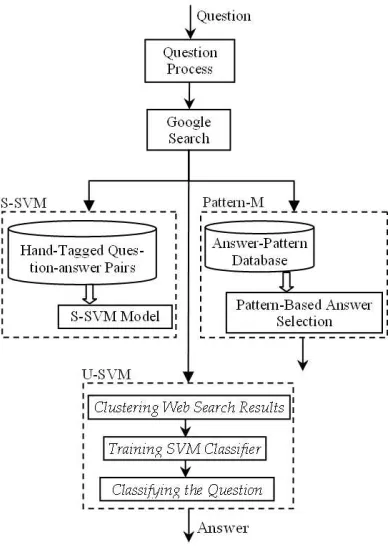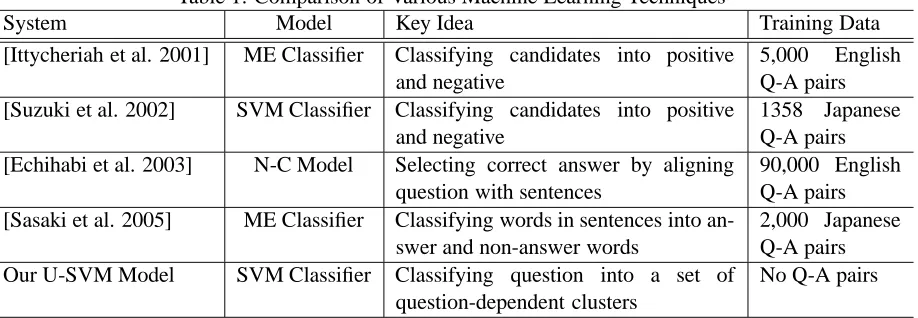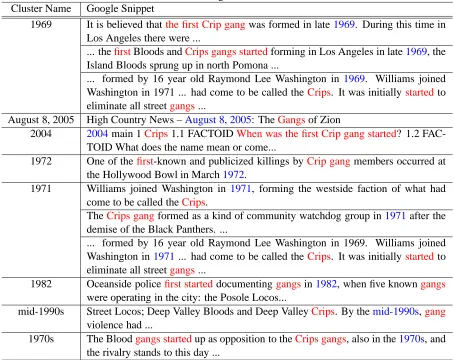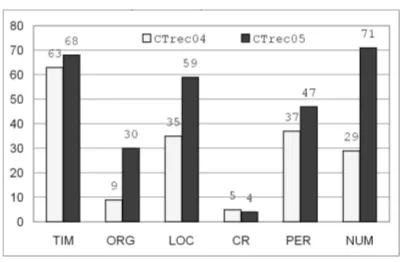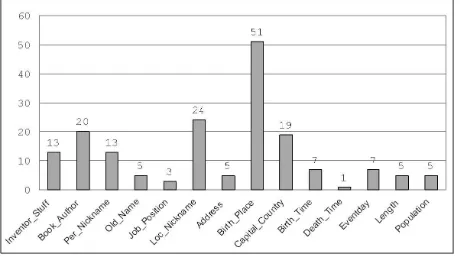Learning Unsupervised SVM Classifier for Answer Selection in Web
Question Answering
Youzheng Wu, Ruiqiang Zhang, Xinhui Hu, and Hideki Kashioka National Institute of Information and Communications Technology (NICT),
ATR Spoken Language Communication Research Labs. 2-2-2 Hikaridai ”Keihanna Science City” Kyoto 619-0288 Japan
{Youzheng.wu,Ruiqiang.zhang,Xinhui.hu,Hideki.kashioka}@atr.jp
Abstract
Previous machine learning techniques for answer selection in question answering (QA) have required question-answer train-ing pairs. It has been too expensive and labor-intensive, however, to collect these training pairs. This paper presents a novel unsupervised support vector machine (U-SVM) classifier for answer selection, which is independent of language and does not re-quire hand-tagged training pairs. The key ideas are the following: 1. unsupervised learning of training data for the classifier by clustering web search results; and 2. select-ing the correct answer from the candidates by classifying the question. The compara-tive experiments demonstrate that the pro-posed approach significantly outperforms the retrieval-based model (Retrieval-M), the supervised SVM classifier (S-SVM), and the pattern-based model (Pattern-M) for answer selection. Moreover, the cross-model com-parison showed that the performance rank-ing of these models was: U-SVM> Pattern-M>S-SVM>Retrieval-M.
1 Introduction
The purpose of answer selection in QA is to se-lect the exact answer to the question from the ex-tracted candidate answers. In recent years, many supervised machine learning techniques for answer selection in open-domain question answering have been investigated in some pioneering studies [Itty-cheriah et al. 2001; Ng et al. 2001; Suzuki et al.
2002; Sasaki, et al. 2005; and Echihabi et al. 2003]. Compared with retrieval-based [Yang et al. 2003], pattern-based [Ravichandran et al. 2002 and Soub-botin et al. 2002], and deep NLP-based [Moldovan et al. 2002, Hovy et al. 2001; and Pasca et al. 2001] answer selection, machine learning techniques are more effective in constructing QA components from scratch. These techniques suffer, however, from the problem of requiring an adequate number of hand-tagged question-answer training pairs. It is too ex-pensive and labor intensive to collect such training pairs for supervised machine learning techniques.
To tackle this knowledge acquisition bottleneck, this paper presents an unsupervised SVM classifier for answer selection, which is independent of lan-guage and question type, and avoids the need for hand-tagged question-answer pairs. The key ideas are as follows:
1. Regarding answer selection as a kind of classi-fication task and adopting an SVM classifier;
2. Applying unsupervised learning of pseudo-training data for the SVM classifier by cluster-ing web search results;
3. Training the SVM classifier by using three types of features extracted from the pseudo-training data; and
4. Selecting the correct answer from the candidate answers by classifying the question. Note that this means classifying a question into one of the clusters learned by clustering web search results. Therefore, our classifying the question
Figure 1: Web Question Answering Architecture
is different from conventional question classifi-cation (QC) [Li et al. 2002] that determines the answer type of the question.
The proposed approach is fully unsupervised and starts only from a user question. It does not require richly annotated corpora or any deep linguistic tools. To the best of our knowledge, no research on this kind of study we discuss here has been reported. Figure 1 illustrates the architecture of our web QA approach. The S-SVM and Pattern-M models are included for comparison.
Because the focus of this paper just evaluates the answer selection part, our approach requires knowl-edge of the answer type to the question in order to find candidate answers, and that the answer must be a NE for convenience in candidate extraction. Ex-periments using Chinese versions of the TREC 2004 and 2005 test data sets show that our approach sig-nificantly outperforms the S-SVM for answer selec-tion, with atop 1score improvement of more than 20%. Results obtained with the test data set in [Wu et al. 2004] show that the U-SVM increases the top 1/mrr 5/top 5scores by 5.95%/6.06%/8.68% as compared with the Pattern-M. Moreover, our
cross-model comparison demonstrates that the per-formance ranking of all models considered is: U-SVM>Pattern-M>S-SVM>Retrieval-M.
2 Comparison among Models
Related researches on answer selection in QA can be classified into four categories. The retrieval-based model [Yang et al. 2003] selects a correct answer from the candidates according to the distance be-tween a candidate and all question keywords. This model does not work, however, if the question and the answer-bearing sentences do not match on the surface. The pattern-based model [Ravichandran et al. 2002 and Soubbotin et al. 2002] first clas-sifies the question into predefined categories, and then extracts the exact answer by using answer pat-terns learned off-line. Although the pattern-based model can obtain high precision for some prede-fined types of questions, it is difficult to define ques-tion types in advance for open-domain quesques-tion an-swering. Furthermore, this model is not suitable for all types of questions. The deep NLP-based model [Moldovan et al. 2002; Hovy et al. 2001; and Pasca et al. 2001] usually parses the user question and an answer-bearing sentence into a semantic represen-tation, and then semantically matches them to find the answer. This model has performed very well at TREC workshops, but it heavily depends on high-performance NLP tools, which are time consuming and labor intensive for many languages. Finally, the machine learning-based model has also been inves-tigated. current models of this type are based on su-pervised approaches [Ittycheriah et al. 2001; Ng et al. 2001; Suzuki et al. 2002; and Sasaki et al. 2005] that are heavily dependent on hand-tagged question-answer training pairs, which not readily available.
Table 1: Comparison of Various Machine Learning Techniques
System Model Key Idea Training Data
[Ittycheriah et al. 2001] ME Classifier Classifying candidates into positive and negative
5,000 English Q-A pairs [Suzuki et al. 2002] SVM Classifier Classifying candidates into positive
and negative
1358 Japanese Q-A pairs [Echihabi et al. 2003] N-C Model Selecting correct answer by aligning
question with sentences
90,000 English Q-A pairs [Sasaki et al. 2005] ME Classifier Classifying words in sentences into
an-swer and non-anan-swer words
2,000 Japanese Q-A pairs Our U-SVM Model SVM Classifier Classifying question into a set of
question-dependent clusters
No Q-A pairs
question. This differs from the supervised tech-niques, in which a large number of hand-tagged training pairs are shared by all of the test ques-tions. In addition, supervised techniques indepen-dently process the answer-bearing sentences, so the answers to the questions may not always be ex-tractable because of algorithmic limitations. On the other hand, the U-SVM can use the interdependence between answer-bearing sentences to select the an-swer to a question.
Table 1 compares the key idea and training data used in the U-SVM with those used in the supervised machine learning techniques. Here, ME means the maximum entropy model, and N-C means the noisy-channel model.
3 The U-SVM
The essence of the U-SVM is to regard answer selec-tion as a kind of text categorizaselec-tion-like classifica-tion task, but with no training data available. In the U-SVM, the steps of ”clustering web search results”, ”classifying the question”, and ”training SVM clas-sifier” play very important roles.
3.1 Clustering Web Search Results
Web search results, such as snippets returned by Google, usually include a mixture of multiple subtopics (called clusters in this paper) related to the user question. To group the web search results into clusters, we assume that the candidate answer in each Google snippet can represent the ”signature” of its cluster. In other words, the Google snippets con-taining the same candidate are regarded as aligned
snippets, and thus belong to the same cluster. Web search results are clustered in two phases.
• A first-stage Google search (FGS) is
ap-plied to extract n candidate answers
{c1, c2, . . . , cn} from the top m Google
snippets {s1, s2, . . . , sm} by a NER tool
[Wu et al. 2005]. Those snippets containing the candidates {ci} and at least one ques-tion keyword {qi} are retained. Finally, the retained snippets {s1, s2, . . . , sm} are
clustered into n clusters {C1, C2, . . . , Cn}
by clustering web search results, that is, If a snippet includesLdifferent candidates, the snippet belongs toLdifferent clusters. If the candidates of different snippets are the same, these snippets belong to the same clusters.
Consequently, the number of clusters {Ci} is fully determined by the number of candidates
{ci}, and the cluster name of a clusterCiis the
candidate answerci. Up to this point, we have
obtained clusters and sample snippets for each cluster that will be used as training data for the SVM classifier. Because this training data is learned automatically, rather than hand-tagged, we call it pseudo-training data.
Google snippets into the clusters learned by the FGS, but does not add new clusters.
For each candidate answerci:
Combine the original queryq={qi}and the candidatecito form a new queryq0= {q, ci}.
Submitq0to Google and download the top 50 Google snippets.
Retain the snippets containing the candi-dateciand at least one keywordqi.
Group the retained snippets intonclusters to form the new pseudo-training data. End
Here, we give an example illustrating the prin-ciple of clustering web search results in the FGS. In submitting TREC 2004 test question 1.1 ”when was the first Crip gang started?” to Google (http://www.google.com/apis), we extract n(= 8)
different candidates from the topm(= 30)Google snippets. The Google snippets containing the same candidates are aligned snippets, and thus the12 re-tained snippets are grouped into8clusters, as listed in Table 2. This table roughly indicates that the snip-pets with the same candidate answers contain the same sub-meanings, so these snippets are considered as aligned snippets. For example, all Google snip-pets that contain the candidate answer 1969 express the time of establishment of ”the first Crip gang”.
In summary, the U-SVM uses the result of ”clus-tering web search results” as the pseudo-training data of the SVM classifier, and then classifies user question into one of the clusters for answer selec-tion. On the one hand, the clusters and their names are based on candidate answers to question; on the other hand, candidates are dependent on question. Therefore, the clusters are question-dependent.
3.2 Classifying Question
Using the pseudo-training data obtained by cluster-ing web search results to train the SVM classifier, we classify user questions into a set of question-dependent clusters and assume that the correct an-swer is the name of the question cluster that is as-signed by the trained U-SVM classifier. For the above example, if the U-SVM classifier, trained on the pseudo-training data listed in Table 2, classifies the above test question into a cluster whose name is
1969, then the cluster name 1969 is the answer to
the question.
This paper selects LIBSVM toolkit1to implement the SVM classifier. The kernel is the radical basis function with the parameterγ = 0.001in the exper-iments.
3.3 Feature Extraction
To classify the question into a question-dependent set of clusters, the U-SVM classifier extracts three types of features.
• A similarity-based feature set (SBFS) is extracted from the Google snippets. The SBFS attempts to capture the word overlap between a question and a snippet. The possible values range from 0 to 1.
SBFS Features
percentage of matched keywords (KWs) percentage of mismatched KWs
percentage of matched bi-grams of KWs percentage of matched thesauruses
normalized distance between candidate and KWs
To compute the matched thesaurus feature, we adopt TONGYICICILIN2in the experiments.
• A Boolean match-based feature set (BMFS) is also extracted from the Google snippets. The BMFS attempts to capture the specific key-word Boolean matches between a question and a snippet. The possible values are true or false.
BMFS Features
person names are matched or not location names are matched or not organization names are matched or not time words are matched or not
number words are matched or not root verb is matched or not
candidate has or does not have bi-gram in snippet matching bi-gram in question candidate has or does not have desired named entity type
• A window-based word feature set (WWFS) is a set of words consisting of the words
1http://www.csie.ntu.edu.tw/ cjlin/libsvm/ 2
Table 2: Clustering Web Search Results Cluster Name Google Snippet
1969 It is believed thatthe first Crip gangwas formed in late1969. During this time in Los Angeles there were ...
... thefirstBloods andCrips gangs startedforming in Los Angeles in late1969, the Island Bloods sprung up in north Pomona ...
... formed by 16 year old Raymond Lee Washington in 1969. Williams joined Washington in 1971 ... had come to be called theCrips. It was initially startedto eliminate all streetgangs...
August 8, 2005 High Country News –August 8, 2005: TheGangsof Zion
2004 2004main 1Crips1.1 FACTOIDWhen was the first Crip gang started? 1.2 FAC-TOID What does the name mean or come...
1972 One of thefirst-known and publicized killings byCrip gangmembers occurred at the Hollywood Bowl in March1972.
1971 Williams joined Washington in 1971, forming the westside faction of what had come to be called theCrips.
TheCrips gangformed as a kind of community watchdog group in1971after the
demise of the Black Panthers. ...
... formed by 16 year old Raymond Lee Washington in 1969. Williams joined Washington in1971... had come to be called theCrips. It was initially startedto eliminate all streetgangs...
1982 Oceanside policefirst starteddocumentinggangsin1982, when five knowngangs
were operating in the city: the Posole Locos...
mid-1990s Street Locos; Deep Valley Bloods and Deep ValleyCrips. By themid-1990s,gang
violence had ...
1970s The Bloodgangs startedup as opposition to theCrips gangs, also in the1970s, and the rivalry stands to this day ...
preceding {wi−5, . . . , wi−1} and following
{wi+1, . . . , wi+5} the candidate answer. The
WWFS features can be regarded as a kind of relevant snippets-based question keywords ex-pansion. By extracting the WWFS feature set, the feature space in the U-SVM becomes ques-tion dependent, which may be more suitable for classifying the question. The number of classi-fication features in the S-SVM must be fixed, however, because all questions share the same training data. This is one difference between the U-SVM and the supervised SVM classifier for answer selection. Each word feature in the WWFS is weighted using its ISF value.
ISF(wj, Ci) =
N(wj, Ci) + 0.5
N(wj) + 0.5
(1)
where N(wj) is the total number of the
snippets containing word feature wj, and
N(wj, Ci)is the number of snippets in cluster
Cicontaining word featurewj.
When constructing question vector, we assume that the question is an ideal question that con-tains all the extracted WWFS words. There-fore, the values of the WWFS word features in question vector are 1. Similarly, the values of the SBFS and BMFS features in question vec-tor are also estimated by self-similarity calcu-lation.
4 Experiments
4.1 Data Sets
in terms of Chinese web QA using three test data sets, which will be published with this paper3. Al-though the U-SVM is independent of the question types, for convenience in candidate extraction, only those questions whose answers are named entities are selected. The three test data sets are CTREC04, CTREC05 and CTEST05. CTREC04 is a set of 178 Chinese questions translated from TREC 2004 FACTOID testing questions. CTREC05 is a set of 279 Chinese questions translated from TREC 2005 FACTOID testing questions. CTEST05 is a set of 178 Chinese questions found in [Wu et al. 2004] that are similar to TREC testing questions except that they are written in Chinese. Figure 2 breaks down the types of questions (manually assigned) in the CTREC04 and CTREC05 data sets. Here, PER, LOC, ORG, TIM, NUM, and CR refer to questions whose answers are a person, location, organization, time, number, and book or movie, respectively.
Figure 2: Statistics of CTEST05
To collect the question-answer training data for the S-SVM, we submitted 807 Chinese questions to Google and extracted the candidates for each ques-tion from the top 50 Google snippets. We then man-ually selected the snippets containing the correct answers as positive snippets, and designated all of the other snippets as negative snippets. Finally, we collected 807 hand-tagged Chinese question-answer pairs as the training data of S-SVM called CTRAIN-DATA.
4.2 Evaluation Method
In the experiments, the topm(= 50) Google snip-pets are adopted to extract candidates by using a
3
Currently no public testing question set for simplified Chi-nese QA is available.
Chinese NER tool [Wu et al. 2005]. The number of the candidates extracted from the topm(= 50) snip-pets,n, is adaptive for different questions but it does not exceed 30. The results are evaluated in terms of two scores,top nandmrr 5. Here, top nis the rate at which at least one correct answer is included in the top n answers, whilemrr 5is the average re-ciprocal rank (1/n) of the highest rankn(n≤5)of a correct answer to each question.
4.3 U-SVM vs. Retrieval-M
The Retrieval-M selects the candidate with the short-est distances to all qushort-estion keywords as the cor-rect answer. In this experiment, the Retrieval-M is implemented based on the snippets returned by Google, while the U-SVM is based on the SGS data, the SBFS and BMFS feature. Table 3 summarizes the comparative performance.
Table 3: Comparison of Retrieval-M and U-SVM
Retrieval-M U-SVM
top 1 27.84% 53.61%
CTREC04 mrr 5 43.67% 66.25%
top 5 71.13% 88.66%
top 1 34.00% 50.00%
CTREC05 mrr 5 48.20% 62.38%
top 5 71.33% 82.67%
The table shows that the U-SVM greatly improves the performance of the Retrieval-M: thetop 1 im-provements for CTREC04 and CTREC05 are about 25.8% and 16.0%, respectively. This experiment demonstrates that the assumptions used here in clus-tering web search results and in classifying the ques-tion are effective in many cases, and that the U-SVM benefits from these assumptions.
4.4 U-SVM vs. S-SVM
To explore the effectiveness of our unsupervised model as compared with the supervised model, we conduct a cross-model comparison of the S-SVM and the U-SVM with the SBFS and BMFS feature sets. The U-SVM results are compared with the S-SVM results for CTREC04 and CTREC05 in Ta-bles 4 and 5, respectively. The S-SVM is trained on CTRAINDATA.
[image:6.612.318.528.340.439.2]Table 4: Comparison of U-SVM and S-SVM on CTREC04
FGS SGS
top 1 S-SVM 30.93% 39.18%
U-SVM 45.36% 53.61%
mrr 1 S-SVM 45.36% 53.54%
U-SVM 57.44% 66.25%
top 5 S-SVM 71.13% 79.38%
U-SVM 76.29% 88.66%
Table 5: Comparison of U-SVM and S-SVM on CTREC05
FGS SGS
top 1 S-SVM 30.00% 33.33%
U-SVM 48.00% 50.00%
mrr 1 S-SVM 45.59% 48.67%
U-SVM 58.01% 62.38%
top 5 S-SVM 72.00% 74.67%
U-SVM 75.33% 82.67%
• The proposed U-SVM significantly outper-forms the S-SVM for all measurements and all test data sets. For the CTREC04 test data set, the top1 improvements for the FGS and
SGS data are about 14.5% and 14.4%, respec-tively. For the CTREC05 test data set, thetop1
score for the FGS data increases from 30.0% to 48.0%, and thetop 1score for the SGS data increases from 33.3% to 50.0%. Note that the SBFS and BMFS features here is fewer than the features in [Ittycheriah et al. 2001; Suzuki et al. 2002], but the comparison is still effective because the models are compared in terms of the same features. In the S-SVM, all questions share the same training data, while the U-SVM uses the unique pseudo-training data for each question. This is the main reason why the U-SVM performs better than the S-U-SVM does.
• The SGS data is greatly helpful for both the U-SVM and the S-SVM. Compared with the FGS data, the top 1/mrr 5/top 5 im-provements for the S-SVM and the U-SVM on CTREC04 are 8.25%/8.18%/8.25% and 7.25%/8.81%/12.37%. The SGS can be re-garded as a kind of query expansion. The
rea-sons for this improvement are: the data sparse-ness in FGS data is partially resolved; and the use of the Web to introduce data redundancy is helpful. [Clarke et al. 2001; Magnini et al. 2002; and Dumais et al. 2002].
[image:7.612.309.538.293.354.2]In the S-SVM, all of the test questions share the same hand-tagged training data, so the WWFS fea-tures cannot be easily used [Ittycheriah et al. 2002; Suzuki, et al. 2002]. Tables 6 and 7 compare the performances of the U-SVM with the (SBFS + BMFS) features, the WWFS features, and combina-tion of three types of features for the CTREC04 and CTREC05 test data sets, respectively.
Table 6: Performances of U-SVM for Different Fea-tures on CTREC04
SBFS+BMFS WWFS Combination
top1 53.61% 46.39% 60.82%
mrr5 66.25% 59.19% 71.31%
[image:7.612.311.539.408.469.2]top5 88.66% 81.44% 88.66%
Table 7: Performances of U-SVM for Different Fea-tures on CTREC05
SBFS+BMFS WWFS Combination
top1 50.00% 49.33% 57.33%
mrr5 62.38% 59.26% 65.61%
top5 82.67% 74.00% 80.00%
These tables report that combining three types of features can improve the performance of the U-SVM. Using a combination of features with the CTREC04 test data set results in the best performances: 60.82%/71.31%/88.66% for top1/mrr 5/top 5. Similarly, as compared with using the (SBFS + BMFS) and WWFS features, the improvements from using a combination of features with the CTREC05 test data set are 7.33%/3.23%/-2.67% and 8.00%/6.35%/6.00%, respectively. The results also demonstrate that the (SBFS + BMFS) features are more important than the WWFS fea-tures.
aver-age top 1 improvements for both test data sets are both more than 20%.
4.5 U-SVM vs. Pattern-M vs. S-SVM
[image:8.612.69.299.265.396.2]To compare the U-SVM with the Pattern-M and the S-SVM, we use the CTEST05 data set, shown in Figure 3. The CTEST05 includes 14 different question types, for example, Inventor Stuff (with question like ”Who invented telephone?”), Event-Day (with question like ”when is World Event-Day for Wa-ter?”), and so on. The Pattern-M uses the depen-dency syntactic answer patterns learned in [Wu et al. 2007] to extract the answer, and named entities are also used to filter noise from the candidates.
Figure 3: Statistics of CTEST05
Table 8 summarizes the performances of the U-SVM, Pattern-M, and S-SVM models on CTEST05.
Table 8: Comparison of U-SVM, Pattern-M and S-SVM on CTEST05
S-SVM Pattern-M U-SVM
top 1 44.89% 53.14% 59.09%
mrr 5 56.49% 61.28% 67.34%
top 5 74.43% 73.14% 81.82%
The results in the table show that the U-SVM significantly outperforms the S-SVM and M, while the S-SVM underperforms the Pattern-M. Compared with the Pattern-M, the U-SVM in-creases the top 1/mrr 5/top 5 scores by 5.95%/ 6.06%/8.68%, respectively. The reasons may lie in the following:
• The Chinese dependency parser influences de-pendency syntactic answer-pattern extraction,
and thus degrades the performance of the Pattern-M model.
• The imperfection of Google snippets affects pattern matching, and thus adversely influences the Pattern-M model. From the cross-model comparison, we conclude that the performance ranking of these models is: U-SVM> Pattern-M>S-SVM>Retrieval-M.
5 Conclusion and Future Work
This paper presents an unsupervised machine learn-ing technique (called the U-SVM) for answer selec-tion that is validated in Chinese open-domain web QA. Regarding answer selection as a kind of classifi-cation task, the U-SVM automatically learns clusters and pseudo-training data for each cluster by cluster-ing web search results. It then selects the correct answer from the candidates according to classifying the question. The contribution of this paper is that it presents an unsupervised machine learning tech-nique for web QA that starts with only a user ques-tion. The results of our experiments with three test data sets are encouraging. As compared with the S-SVM, thetop1 performances of the U-SVM for the CTREC04 and CTREC05 data sets are signifi-cantly improved, at more than 20%. Moreover, the U-SVM performs better than the Retrieval-M and the Pattern-M.
References
Abdessamad Echihabi, and Daniel Marcu. 2003. A Noisy-Channel Approach to Question Answering. In
Proc. of ACL-2003, Japan.
Abraham Ittycheriah, Salim Roukos. 2002. IBM’s
Sta-tistical Question Answering System-TREC 11. In Proc.
of TREC-11, Gaithersburg, Maryland.
Bernardo Magnini, Matteo Negri, Roberto Prevete, Hristo Tanev. 2002. Is It the Right Answer?
Exploit-ing Web Redundancy for Answer Validation. In Proc.
of ACL-2002, Philadelphia, pp. 425 432.
Charles L. A. Clarke, Gordon V. Cormack, Thomas R. Lynam. Exploiting Redundancy in Question
Answer-ing In Proc. of SIGIR-2001, pp 358–365, 2001.
Christopher Pinchak, Dekang Lin. 2006. A Probabilistic
Answer Type Model. In Proc. of EACL-2006, Trento,
Italy, pp. 393-400.
Dan Moldovan, Sanda Harabagiu, Roxana Girju, et al. 2002. LCC Tools for Question Answering. NIST Spe-cial Publication: SP 500-251, TREC-2002.
Deepak Ravichandran, Eduard Hovy. 2002. Learning
Surface Text Patterns for a Question Answering Sys-tem. In Proc. of the 40th ACL, Philadelphia, July 2002.
Eduard Hovy, Ulf Hermjakob, Chin-Yew Lin. 2001. The
Use of External Knowledge of Factoid QA. In Proc.
of TREC 2001, Gaithersburg, MD, U.S.A., November 13-16, 2001.
Hui Yang, Tat-Seng Chua. 2003. QUALIFIER: Question
Answering by Lexical Fabric and External Resources.
In Proc. of EACL-2003, page 363-370.
Hwee T. Ng, Jennifer L. P. Kwan, and Yiyuan Xia. 2001.
Question Answering Using a Large Text Database: A Machine Learning Approach. In Proc. of
EMNLP-2001, pp66-73 (2001).
Jun Suzuki, Yutaka Sasaki, Eisaku Maeda. 2002. SVM
Answer Selection for Open-Domain Question Answer-ing. In Proc. of Coling-2002, pp. 974 980 (2002).
Marius Pasca. 2001. A Relational and Logic
Represen-tation for Open-Domain Textual Question Answering.
In Proc. of ACL (Companion Volume) 2001: 37-42.
Martin M. Soubbotin, Sergei M. Soubbotin. 2002. Use of
Patterns for Detection of Likely Answer Strings: A Sys-tematic Approach. In Proc. of TREC-2002,
Gaithers-burg, Maryland, November 2002.
Susan Dumais, Michele Banko, Eric Brill, Jimmy Lin, and Andre Ng. Web Question Answering: Is More
Always Better?. In Proc. SIGIR-2002, pp 291–298,
2002.
Xin Li, and Dan Roth. 2002. Learning Question
Classi-fication. In Proc. of the 19th International Conference
on Computational Linguistics, Taibai, 2002.
Youzheng Wu, Hideki Kashioka, Jun Zhao. 2007.
Us-ing ClusterUs-ing Approaches to Open-domain Question Answering. In Proc. of CICLING-2007, Mexico City,
Mexico, pp506 517, 2007.
Youzheng Wu, Jun Zhao and Bo Xu. 2005. Chinese
Named Entity Recognition Model Based on Multiple Features. In Proc. of HLT/EMNLP-2005, Vancouver,
Canada, pp.427-434.
Youzheng Wu, Jun Zhao, Xiangyu Duan and Bo Xu. 2004. Building an Evaluation Platform for Chinese
Question Answering Systems. In Proc. of the First NCIRCS, China, December, 2004.
Yutaka Sasaki. 2005. Question Answering as
